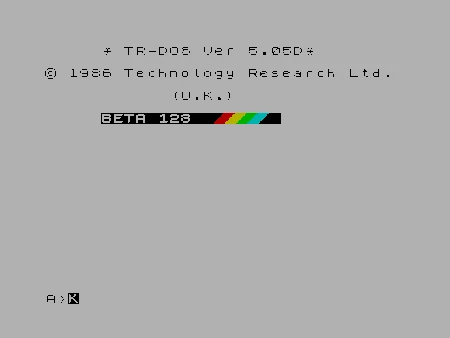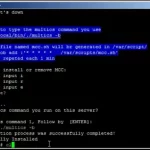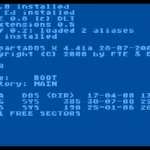Web site: (not active)
Origin: United Kingdom
Category: Desktop
Desktop environment: CLI
Architecture: ZX Spectrum
Based on: Independent
Wikipedia: TR-DOS
Media: Install
The last version | Released: 5.03 | 1986
TR-DOS – a disk operating system for home computers compatible with the ZX Spectrum. Developed by Technology Research Ltd (England) in 1984.
TR-DOS is a software part of a hardware-software solution consisting of the Beta Disk Interface (drive controller) and TR-DOS itself, contained in the Beta Disk Interface ROM. In the original computer models, the device was connected to the standard system connector of the computer, in Russian clones it was implemented both as a separate device and as part of the main computer board (for example, in the Pentagon 128 and Scorpion ZS-256 computers). Supported floppy disk drives are 5¼” and 3½” and logical disk formats from SD/SS to DD/DS.
The maximum capacity of a standard floppy disk marked in TR-DOS is 655,350 bytes (including the directory, but not counting the tracks above the standard 80). The directory capacity is 128 file names. The files are continuous. After deleting files (if there are undeleted files behind them), if it is necessary to free up disk space under deleted files, it is necessary to perform the MOVE compression operation. In addition to working with files, this system allowed dumping a memory image to disk with the possibility of subsequent launch.
The hardware responsible for this feature left much to be desired. Only the Profi-3.* interface version began to use a trigger for pulse generation, rather than a monostable multivibrator, eliminating repeated NMI processing, which overloaded the stack and led to a reset. On the same version of the interface, a digital PLL was first used, significantly improving the quality of reading floppy disks. Unfortunately, in the basic versions, the NMI processing software module was written completely ineptly. In addition to the fact that a large stack size was consumed, several memory cells were damaged, and the interrupt mode was restored empirically – by renaming the image file. To launch an image in im2 mode, it was necessary to add the $ symbol to the beginning of the name. The latter is due to the fact that the Z80 does not have commands for reading the current interrupt mode. However, it is not only possible, but also very easy to determine the interrupt type on the ZX by software. But only directly during the execution of the NMI processing subroutine. The trick is based on the fact that there can be practically only two types of interrupts on the ZX.
For the rest, there is no difference. It is enough to create a small software trap on im2 in RAM and wait for one interrupt to be processed. If the trap worked, im2 was used. All the listed shortcomings were successfully solved in version TR-DOS 5.34 (released in 1997, the version number was chosen exclusively for compatibility with the version of the existing software and to distinguish it from other versions). And the ability to replace the standard NMI processing area with RAM made it possible to dump even such “super protected programs” as UFO, UFO-2 to disk and successfully launch them. Abroad, these images were called Snapshot. Analysis of the code of “hacked” games clearly demonstrates that it was the magic buttons that made it possible to put carefully coded programs on stream.




